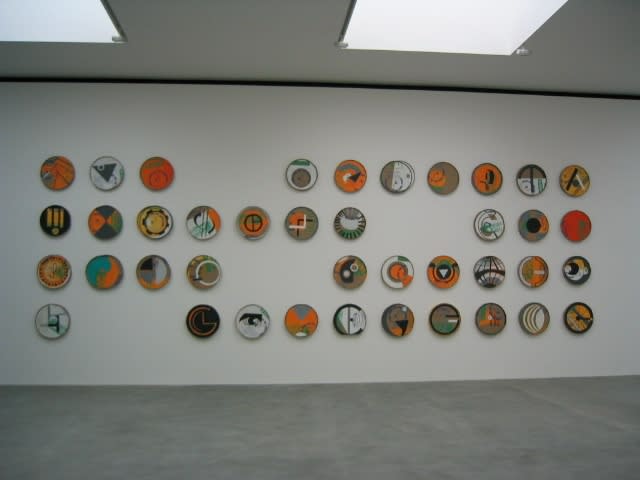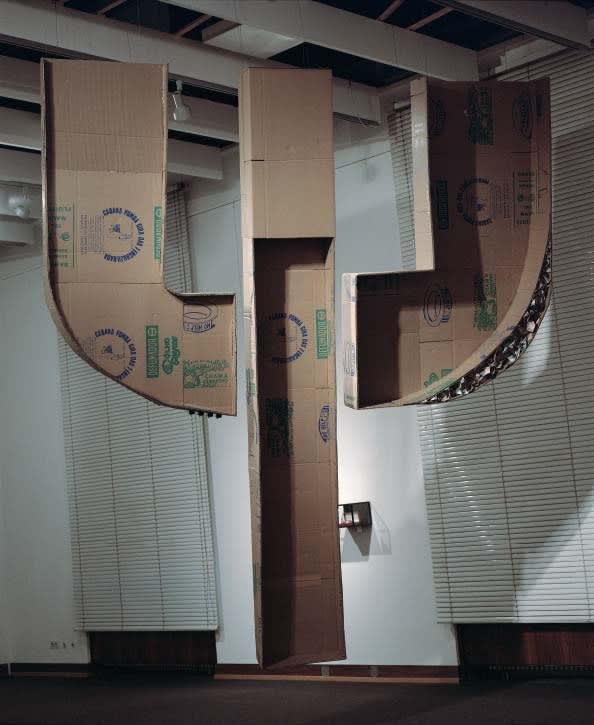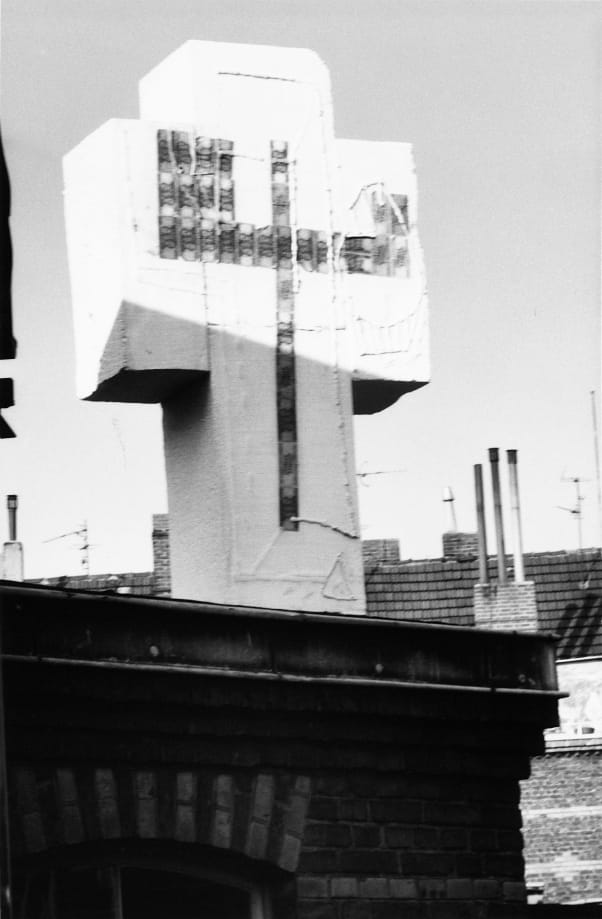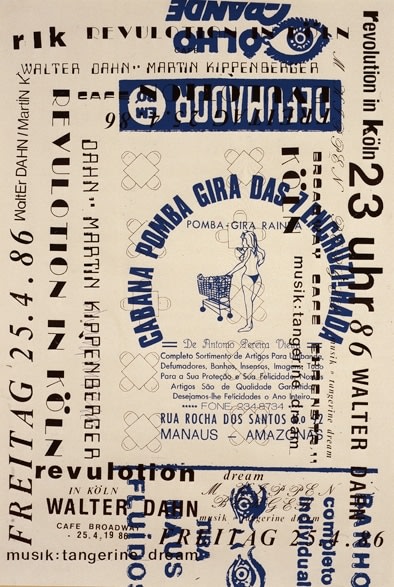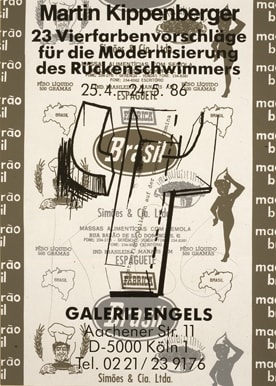Martin Kippenberger
Martin Kippenberger‘s ‚Magical Misery Tour‘ through Brasil lasted from the 15th December 1985 to the 22nd March 1986. Three months in Brasil were too long just to be fun, it was Brasil until it hurt.
Besides Rio de Janeiro, Kippenberger also visited the North of the country, acquired a gas station by the sea in Salvador de Bahia and named it ´Tankstelle Martin Bormann/Gas Station Martin Bormann‘´. The rumour that this prominent exponent of National Socialism had fled to South America at the end of the Second World War was still persistent in the 1980‘s. With the fictionally acquired gas station, Kippenberger gave Bormann a camouflage address and the possibility of an income in exile. Kippenberger allegedly installed a telephone line and employees were obliged to answer calls with ‘Tankstelle Martin Bormann’.
The spoils of this journey included diaries, posters, post cards, catalogues, a concert, records (together with Albert Oehlen), printed t-shirts, sculptures, photographs, graphics, the installation with the name ´Tankstelle Martin Borman´, and several series of paintings. These paintings feature, apart from Brasil´s modernistic architectural forms, the ‚round‘ in all its multiple variations. After his return Kippenberger said that Brazil was first and foremost round – the ever-shining sun, the curving ornamentation of the Copacabana, the round forms of women in their bikinis…
Sheets of cardboard were silk-screened and painted with advertising slogans from simple Brazilian paper napkins and product logos, together with a schematic depiction of Kippenberger´s hat (A MASSA NO HELP). They were not only used for the sculptures ´Rückenschwimmer/War Gott ein Stümper/ Backstroker/ Was God a Bungler‘ and ´Baumaßnahme/ Construction Measure´, but also served as a basis for the 40 round Tondi and for the frames of the paintings. In Kippenberger´s first monographic museum exhibition `Miete Strom Gas/ Rent Electricity Gas´ at the Landesmuseum in Darmstadt in 1986, these works formed the core of the exhibition.
Kippenberger stuffed the back side of the sculpture ´Rückenschwimmer /War Gott ein Stümper/ Backstroker/Was God a Bungler’ with Brazilian bank notes; the monetary crisis during his visit to Brazil was a further reference to German history. Beside the evocation of a famous Nazi through the naming of an old gas station, the devaluation of the Brazilian currency in the middle of the Eighties recalled the rapid decline in value of the Reichsmark in the Weimar Republic.
„Schreiende Sonne. Sambaakzente. Kreischende, psychedelische Flammen. Sündhaft teurer Whisky. Love-Kino volle Breite. Vibrierende Tänzerinnen. Mitreissende Hits, Mindestverzehr. Wochenendcocktail. Stunden des Countdowns. Endlose Darbietungen wie Haarekämmen. Grooveabteilungen. Zappelnde Scheisse. Frivole Tischbestellungen von Air-Guitars begleitet. Ausgezeichnetes Bier vom Faß. Gutgelaunte Momente, Inferninios. Mac Donalds. Krach. Mulattenpupillen. Scherbenvariante. Arschvitrinen. Aufpassende Frauen. Andere Burschen. Äquivalent für Jesus. Schrille hübsche Töchter von Papa Hemingway. Devotionalien für die Macumba. Geldwechseln. Tolle Tage. Grinsende Straßen. Verdatterte Schnelligkeit. Eis mit Cola. Cola mit Eis. Versetzte Tanzflächen. Oskar Niemeyer. Entfesselte Energien. Billig, teuer, Dollar weg, Cuzero rein, je oller, je doller. Freistilbalancen. Noch ein bisschen Geld wechseln. Vorhang zur Seite. Straßenclubs. Ekstase im Unterhemd. Jede Menge Puppen. Cooler Effekt. Vielfalt und Unbefangenheit. Dolby selber mitbringen. Palado bonno. Welch ein Traum. Die Becken rufen. Die Kellner winken uns nach. Aber das glaubt uns doch zu Hause keiner.“ (from the Rio Tagebuch by Martin Kippenberger, 1986)
-
 Martin KippenbergerGarota de Ipanema IV, 1986Acrylic, lacquer, fabric and collage on canvas180 x 150 cm / 70.86 x 59.05 inches
Martin KippenbergerGarota de Ipanema IV, 1986Acrylic, lacquer, fabric and collage on canvas180 x 150 cm / 70.86 x 59.05 inches -
 Martin KippenbergerNachträglicher Entwurf zum Mahnmal Tankstelle Martin Bormann, 1986Acrylic and silicon on canvas180 x 150 cm / 70.86 x 59.05 inches
Martin KippenbergerNachträglicher Entwurf zum Mahnmal Tankstelle Martin Bormann, 1986Acrylic and silicon on canvas180 x 150 cm / 70.86 x 59.05 inches -
 Martin KippenbergerTondi, 1986Screen print on cardboard, wooden construction, acrylic, forty partsDiameter between 54 and 59 cm / 21.25 x 23.22 inches
Martin KippenbergerTondi, 1986Screen print on cardboard, wooden construction, acrylic, forty partsDiameter between 54 and 59 cm / 21.25 x 23.22 inches
Height 6,5 cm each / 2.55 inches -
 Martin KippenbergerTankstelle Martin Bormann, 1986Photograph mounted on wood, four partseach 350 x 125 cm / 137.79 x 49.21 inches
Martin KippenbergerTankstelle Martin Bormann, 1986Photograph mounted on wood, four partseach 350 x 125 cm / 137.79 x 49.21 inches
overall 350 x 500 cm / -
 Martin KippenbergerBaumaßnahme, 1986Screen print on cardboard, wooden construction, two parts225 x 100 x 210 cm / 88.58 x 39.37 x 82.67 inches
Martin KippenbergerBaumaßnahme, 1986Screen print on cardboard, wooden construction, two parts225 x 100 x 210 cm / 88.58 x 39.37 x 82.67 inches
225 x 225 x 18 cm / 88.58 x 88.58 x 7.08 inches -
 Martin KippenbergerRückenschwimmer / War Gott ein Stümper, 1986Screen print on cardboard, wood, three parts380 x 60 x 27 cm / 149.6 x 23.62 x 10.62 inches
Martin KippenbergerRückenschwimmer / War Gott ein Stümper, 1986Screen print on cardboard, wood, three parts380 x 60 x 27 cm / 149.6 x 23.62 x 10.62 inches
230 x 140 x 27 cm / 90.55 x 55.11 x 10.62 inches
230 x 120 x 27 cm / 90.55 x 47.24 x 10.62 inches -
 Martin KippenbergerRückenschwimmer, 1986Styropos, cruzeiros, silikon, foto auf sockel200 x 150 x 40 cm / 78.74 x 59.05 x 15.74 inches
Martin KippenbergerRückenschwimmer, 1986Styropos, cruzeiros, silikon, foto auf sockel200 x 150 x 40 cm / 78.74 x 59.05 x 15.74 inches -
 Martin Kippenberger14.000.000, - Für Ein HallöchenMartin Kippenberger / Albert OehlenGalerie Ascan Crone, Hamburg, 1986Offset60 x 41.7 cm / 23.62 x 16.41 inches
Martin Kippenberger14.000.000, - Für Ein HallöchenMartin Kippenberger / Albert OehlenGalerie Ascan Crone, Hamburg, 1986Offset60 x 41.7 cm / 23.62 x 16.41 inches -
 Martin KippenbergerRevolution in KölnMartin Kippenberger / Walter DahnBroadway Café, Köln, 1986Silkscreen87.7 x 60.1 cm / 34.52 x 23.66 inches
Martin KippenbergerRevolution in KölnMartin Kippenberger / Walter DahnBroadway Café, Köln, 1986Silkscreen87.7 x 60.1 cm / 34.52 x 23.66 inches -

-
 Martin KippenbergerDie Hamburger Hängung - Umzüge 1957-1988 Fallende FlügeGalerie Gisela Capitain Köln, 1989Silkscreen75 x 62.8 cm / 29.52 x 24.72 inches
Martin KippenbergerDie Hamburger Hängung - Umzüge 1957-1988 Fallende FlügeGalerie Gisela Capitain Köln, 1989Silkscreen75 x 62.8 cm / 29.52 x 24.72 inches -

-
 Martin Kippenberger23 Vierfarbenevorschläge für die Verbesserung des RückenschwimmersGalerie Engels, Köln, 1986Silkscreen83.7 x 59.5 cm / 32.95 x 23.42 inches
Martin Kippenberger23 Vierfarbenevorschläge für die Verbesserung des RückenschwimmersGalerie Engels, Köln, 1986Silkscreen83.7 x 59.5 cm / 32.95 x 23.42 inches


